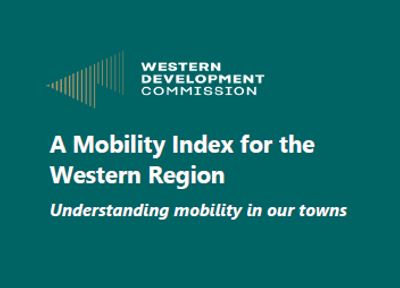
Date: 03 Feb 2022
Innovative approach to measuring transport services and accessibility in rural centres
Mobility plays an essential role in economic prosperity and quality of life in small towns. The Western Development Commission are currently working to create a Mobility Index to allow rural centres in the Western Region to gauge the health of their mobility systems and their readiness for future transport and mobility opportunities.
The WDC Mobility Index will set a baseline measure of current transport, mobility and accessibility in rural centres in the Western Region. Using the WDC Index towns will be able to gauge the health of their mobility systems and understand the opportunities for future mobility solutions in rural centres.
Why a Mobility Index?
A Mobility Index enables easy comparison between places and across different objectives and allows improvements to be measured over time. Mobility Indexes are made up of a variety of indicators combined to create a single score for each place.
An Index can show which town is in the best position for access to services, or employment, or readiness for the low carbon transition. It can highlight towns which are performing especially well and show which towns need targeted improvements.
The WDC Index and Themes
As mobility indices are usually urban focused, the WDC Mobility Index represents an innovative approach to measuring transport services and accessibility in rural centres. There will be 30 different indicators making up this WDC Index.
To provide better insights and comparisons the WDC Mobility Index will have different mobility related themes reflecting key areas for which good mobility and accessibility is essential. The following themes will be used in this Index:
1. Economic and Employment activity
2. Quality of life and social inclusion
3. Low carbon readiness.
Which Places?
Given our focus on rural centres the WDC Mobility Index will be prepared for 34 towns in the Western Region with a population between 1,500 and 9,9991.
Town Profiles
It is important to consider the different characteristics and functions of towns, for example those which are largely commuter towns will have different mobility attributes to towns reliant or tourism. The peripherality and accessibility of the towns relative to cities or larger towns will also be important. A detailed profile of each town, along with an infographic for the town, will be created to accompany the Mobiity Index.
These will provide for greater understanding of each centre’s issues and will show how different places perform in relation to various objectives
Vision
The WDC Mobility Index for the region will set a baseline measure of current transport, mobility and accessibility in small rural towns. It will be updated regularly providing comparisons over time and among towns.
This Index will be a way for local, regional and national government, transport providers of all kinds and people in the places themselves to understand their mobility systems and their readiness for future transport and mobility patterns.
Policy Alignment
This work aligns with six of the National Development Plans Strategic Outcomes, while the focus on more sustainable mobility in Our Rural Future and of course in Climate Action policy have been significant drivers of this project. A baseline understanding of rural mobility will also allow us better understand potential future mobility solutions and the opportunities for Mobility as a Service (MaaS) in small towns and rural areas.
Working Group
A small external working group for the project has been established to refine and agree indicators and identify data sources and priorities for the WDC Index. Members of the working group will also provide insights on Index scores and recommendations and policy proposals for towns which need to improve mobility and access.
Duration of the Project
The WDC Mobility Index and accompanying report will be published in the second half of 2022 and will be revised in 2024 taking account of new Census data. The Index will in future reflect the improvements to rural bus services planned in the National Transport Authority’s Connecting Ireland and will also monitor other changes in mobility in these towns into the future.